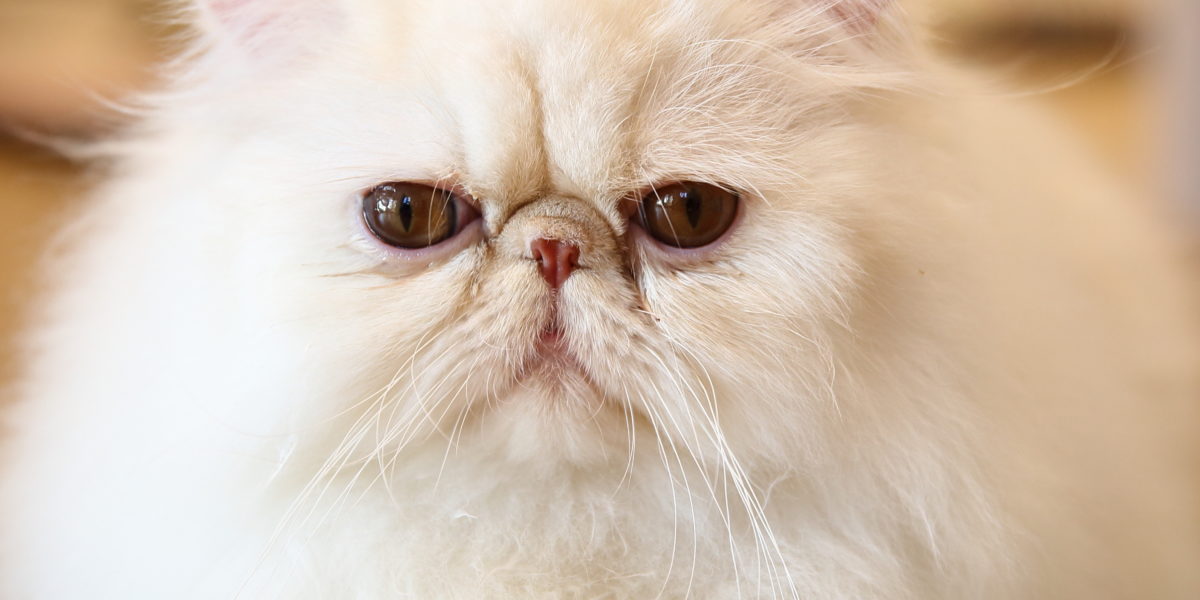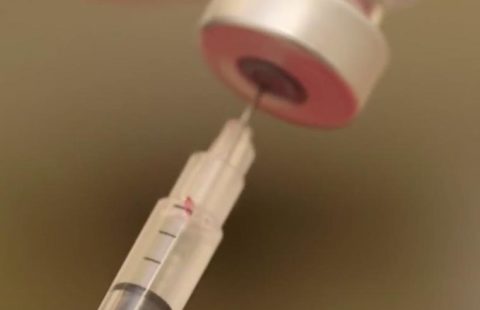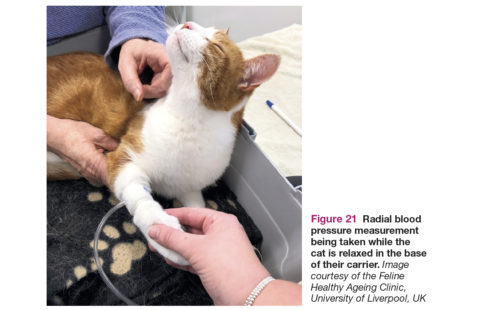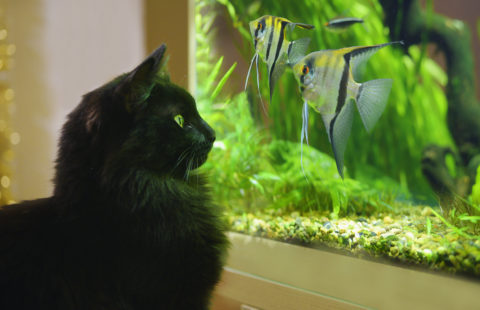Pedigree cats have been bred to come in a range of body shapes and sizes, with head shapes that also vary from long and pointed to round and flat. Those with flat faces and short noses are termed brachycephalic (the same term is used for dogs such as bulldogs and pugs), and the breeds most affected are Persians and Exotic Shorthairs. Sadly, this flat-faced look is directly linked to a number of health issues.
At International Cat Care, we have always had a collaborative relationship with breeders – indeed, we were founded by cat breeder and cat lover Joan Judd over 60 years ago. Therefore, we understand that reputable breeders care deeply about the welfare of their cats and would never knowingly breed cats to suffer. However, others continue to breed cats where the potential for suffering is guaranteed. Many owners are completely unaware of the health issues surrounding these breeds and would be horrified to discover that their beloved pet was suffering.
There is absolutely no criticism intended of existing owners of these breeds, by either welfare organisations or veterinary professionals. The growing brachycephalic campaign is all about raising awareness of the serious health and welfare issues associated with these breeds, bringing this to the attention of those who might consider becoming owners of them, and to those who currently breed them and are bringing the next generations of such cats into being.
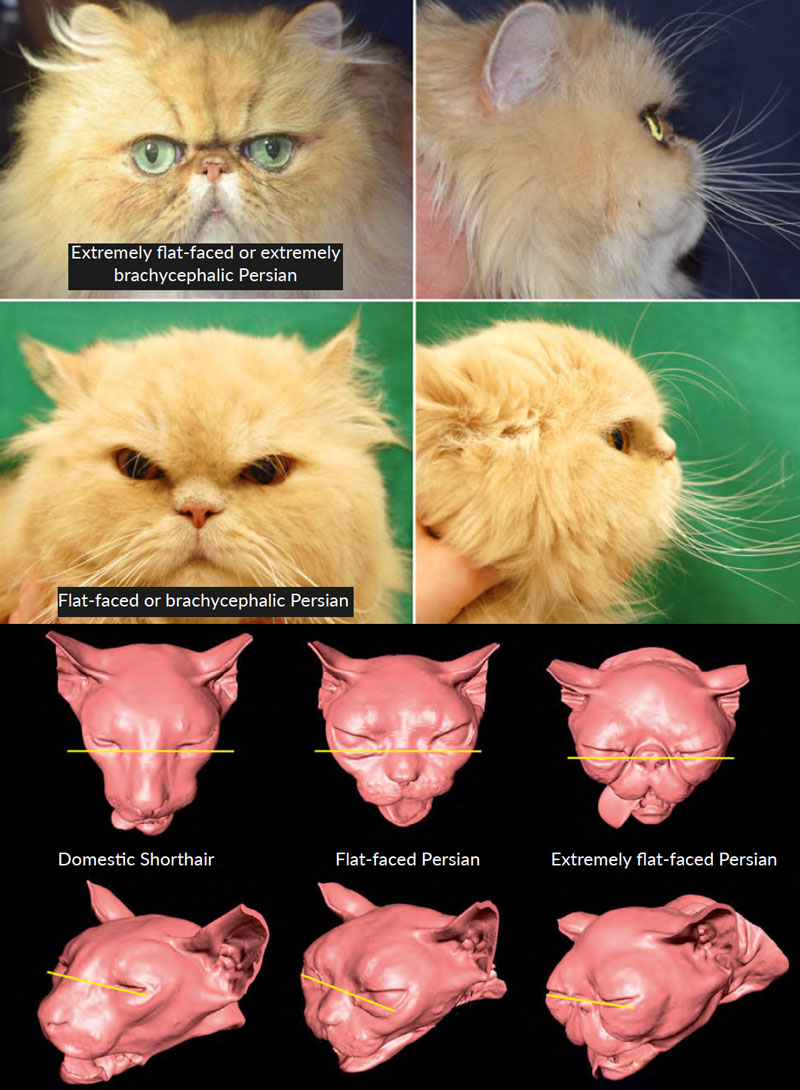
As you can see from the images above, the more extreme flat-faced cat (far right) has a much shorter nose and flatter face than both the Domestic Shorthair and the less extreme flat-faced cat (middle) (reproduced with permission from Schmidt et al 2017).
For breeders, changing anything about the cats and dogs they champion and have worked so hard to shape, based on breed standards and what judges are awarding on the show bench, may be an unwelcome prospect. However, the evidence can no longer be ignored: animals are suffering, because of a human pursuit for a certain look. We have created cats that cannot breathe normally, and have reduced breathing capacity (pinch your nose slightly to feel what this is like), that can’t run, jump and climb (important behaviours for cats) without distress, that often have protruding eyes that can become damaged and painful, skin that can get infected, and that can’t even eat without difficulty. This is what we must not lose sight of. A cat’s health and welfare must come before its looks.
The aim of this article is to explain research from a new study from Germany* published in the Journal of Veterinary Internal Medicine in September 2017, highlighting the welfare issues associated with modern Persians. This research found that in extremely flat-faced Persians, the increased shortening of the nose and flattening of the face was associated with severe skull and brain abnormalities.
Research
The study looked at 45 flat-faced and 47 extremely flat-faced Persians and found that the jawbones of those with extreme brachycephaly were clearly misaligned, the cats had no visible part of the skull for the jaw muscles to attach to, some had a protruding lower jaw, and some also showed teeth abnormalities, all of which may lead to eating difficulties. Other deformities included ‘osseous defects’ – the holes in the skull you can see in the figure below. These were most pronounced in the kitten skulls you can see in this figure (two images bottom right). Abnormalities in the bones of the nasal cavity led to some blocking of the nasal passages, which would result in breathing difficulties.

Magnetic Resonance Imaging (MRI) scans of the cats’ skulls. The two bottom right images are two extreme flat-faced kittens. (Reproduced with permission from Schmidt et al 2017).

The more extreme flat-faced cat (images in the right-hand column) has an abnormally dome-shaped skull compared to both the Domestic Shorthair (images to the left) and the less extreme flat-faced cat (images in the middle) (reproduced with permission from Schmidt et al 2017).
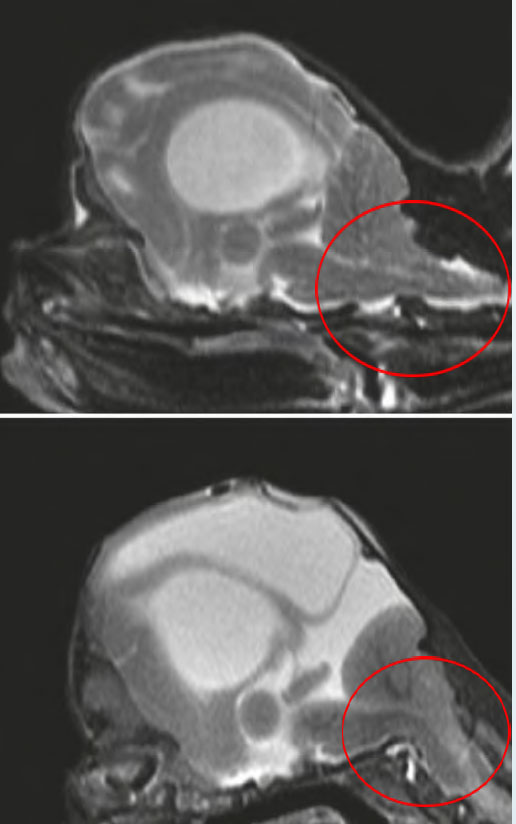
In five extremely flat-faced kittens, brain compression was so severe that the back of the brain had been pushed out of the skull into the space in the spine where the spinal cord is. (Reproduced with permission from Schmidt et al 2017)
The extremely flat-faced Persians also had abnormally dome-shaped skulls (see figure above). The space inside the braincase was reduced, leading to compression of the brain. A third of these Persians had clear signs of internal hydrocephalus – a build-up of fluid inside the brain. This is associated with lots of problems in cats including seizures and blindness. In most of the extremely flat-faced Persians, the back of the brain was even protruding out of the base of the skull and into the spinal cord (this was also seen in some of the less extremely flat-faced Persians). In five extremely flat-faced kittens, brain compression was so severe that the back of the brain had been pushed out of the skull into the space in the spine where the spinal cord is (see figure right). These kittens were unable to stand or walk properly, were not alert, had head tremors, uncontrolled eye movements and misaligned eyes, abnormal breathing patterns, and their owners reported sessions of long-lasting, aimless screaming. The kittens were put to sleep. The suffering in these kittens’ short lives, because of the desire for a certain look, is totally unacceptable.
The researchers reported that the owners of the extremely flat-faced Persians in the study ‘often describe their cats as ‘dummies’, sometimes running into objects or falling from the windowsill. They are often uninterested in playing and have reduced social interactions with other cats and with the owner’. This suggests that the cats might have neurological problems.
The researchers discuss the fact that breeders may believe that the brachycephalic facial features of the extremely flat-faced cats are simply accentuated features on a normal spectrum of head shape in the domestic cat. However, they point out that this is in contrast to our perception of human head shape, where brachycephaly is not seen as a normal characteristic, but a clinical symptom indicating an abnormality associated with various genetic diseases. The skull shape and the brain changes in these extremely flat-faced Persians found in this study are ‘strikingly similar’ to children with a condition called coronal craniosynotosis, and so can be considered as a feline version of this condition, according to the researchers.
The authors of the study conclude that ‘breeders and cat fanciers must face the fact that the desired phenotypic traits in these cats would be considered a severe developmental abnormality in humans. The selection for extreme forms of brachycephaly must be reconsidered’.
Conclusion
As the evidence for the suffering endured by extremely flat-faced cats mounts, breeding these cats can no longer be justified. All those concerned about animal suffering must take a stand for feline welfare by choosing not to buy extremely flat-faced Persians and Exotic Shorthairs, and by being vocal about the suffering these cats experience. Cat registration and showing organisations, breed clubs and advisory committees, judges and breeders must work together alongside veterinary professionals, welfare organisations and academics to change the breeding and judging standards of Persians, returning to a more normal nose length and skull shape, so as to eliminate the health issues associated with brachycephaly.
International Cat Care will continue to campaign for this cause. As breeder and cat lover Joan Judd said when she founded International Cat Care over 60 years ago, ‘We shall not tolerate suffering.’
Reference *Schmidt MJ, Kampschulte M, Enderlein S et al. The relationship between brachycephalic head features in modern Persian cats and dysmorphologies of the skull and internal hydrocephalus. Journal of veterinary internal medicine. 2017 Sep 1;31(5):1487-501.



